Las Dehesas de Sierra Morena

Image: CMA de la Junta de Andalucía
Information from UNESCO Biosphere Reserve Directory
Regions of SpainGeneral Description The Dehesas de Sierra Morena was declared a biosphere reserve in 2002. The Dehesas de Sierra Morena embraces the Aracena and Picos de Aroche Nature Park in Huelva, the Sierra Norte in Seville, and the Sierra de Hornachuelos in Córdoba. The biosphere reserve integrates 43 municipalities in three provinces, with a total population of more than 90,000 (2002). The area is recognized for its important cultural heritage, and has large expansive areas of holm and cork oaks, surrounded by pasture, meadows and Mediterranean scrub. The dehesas are an agrosilvopastoral system that has enhanced the maintenance of an extraordinarily high biodiversity. The traditional use is characterized by mixed livestock raising at low stocking densities, employment of hardy regional breeds and an elaborated maintenance and exploitation of holm oaks. Livestock production has traditionally been accompanied by arable systems with long rotations and closed nutrient cycles without external inputs of fodder, fertilizers and agro-chemicals. Modern trends are a specialization toward lamb and beef production and the employment of intensive techniques like free range grazing at high stocking levels or crossbreeding with high-performance breeds.
Major ecosystem type Evergreen sclerophyllous forests, woodlands or scrub
Major habitats & land cover types Dehesas (agropastoral system) dominated by Quercus suber and Q. rotundifolia; matorral noble with Quercus coccifera, Pistacea lentiscus, P. therebintus, Asparagus acutifolius etc.; Castania sativa habitats; gallery forests with Alnus glutinosa, Ulmus minor, Fraxinus angustifolia, Celtis australis etc.; traditional agricultural lands with Olea europea sylvestris, Castanea sativa, Asparagus spp. Etc.
- Albufera de Adra
- Bahia de Cadiz
- Cabo de Gata-Nijar
- Climate of Andalusia
- Doñana
- Flora and wildlife of Andalusia
- Geography of Andalusia
- Grazalema
- History of Andalucia
- Laguna de Fuente de Piedra
- Las Dehesas de Sierra Morena
- Las Sierras de Cazorla y Segura
- Los Alcornocales
- Nature reserves in Andalusia
- Ordiel Marshes
- Sierra Nevada
- Aiguamolls de l’Empordà Natural Park
- Aigüestortes i Estany de Sant Maurici
- Birding sites in Catalonia
- Cap de Creus
- Catalonia earthquake of 1428
- Congost de Mont-rebei / Mont-rebei gorge
- Delta del Ebro
- Els Ports
- Garraf
- Lake Banyoles
- Lerida Steppes
- Montseny
- Pica d’Estats
- Sant Llorenç del Munt
- Serra de Montsec
- Sierra de Cadi
The Iberianature guide to Spain


 Andalusia with its rugged mountains and stunning scenery offers some of the best hiking in Europe.
Andalusia with its rugged mountains and stunning scenery offers some of the best hiking in Europe.